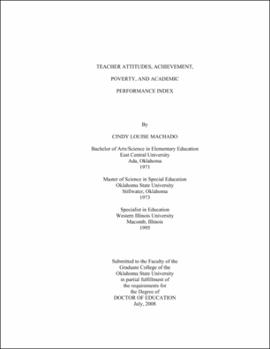| dc.contributor.advisor | Stern, Kenneth | |
| dc.contributor.author | Machado, Cindy Louise | |
| dc.date.accessioned | 2013-11-26T08:34:42Z | |
| dc.date.available | 2013-11-26T08:34:42Z | |
| dc.date.issued | 2008-07 | |
| dc.identifier.uri | https://hdl.handle.net/11244/7492 | |
| dc.description.abstract | Scope and Method of Study: This study tested Social Identity Theory by identifying, comparing, and contrasting attitudes of elementary school teachers at Title I elementary schools in Oklahoma categorized as high poverty/high achieving and high poverty/low achieving. An on-line survey was sent to building principals who then forwarded the survey to elementary school teachers for completion. The Organizational Climate Description Questionnaire for Elementary Schools (Hoy, 1986) was used to evaluate climate indexes within each school and within the high and low performing groups. | |
| dc.description.abstract | Findings and Conclusions: Poverty is hard to overcome, and must be recognized as one of the most important variables in a low performing school. Poverty does not have to dictate academic achievement. Elements in some high poverty schools create an environment where poor students can achieve as well or better than affluent students. Schools must make a conscious effort to develop climate elements that contribute to a positive environment. Leadership, ambitious instruction, and a positive student-centered school climate contribute significantly to student performance. Teachers must place emphasis on high expectations for students when the goal is academic excellence. The higher the poverty rate, particularly when the rate was 80% or more, the lower the predicted Academic Performance Index (API). Two variables that influence student achievement are teacher quality and leadership quality. It can be concluded that students in high poverty/low achieving schools need the best teachers under the leadership of an effective and experienced leader. Principal tenure of five years or more predicted a higher API. A regression analysis predicted that more collegiality and less disengaged behavior would be found in high achieving schools. Restrictive principal behavior was predicted to be present in high achieving schools. | |
| dc.format | application/pdf | |
| dc.language | en_US | |
| dc.rights | Copyright is held by the author who has granted the Oklahoma State University Library the non-exclusive right to share this material in its institutional repository. Contact Digital Library Services at lib-dls@okstate.edu or 405-744-9161 for the permission policy on the use, reproduction or distribution of this material. | |
| dc.title | Teacher attitudes, achievement, poverty, and academic performance index | |
| dc.contributor.committeeMember | Forsyth, Patrick | |
| dc.contributor.committeeMember | Mathers, Judith | |
| dc.contributor.committeeMember | Bull, Kay | |
| osu.filename | Machado_okstate_0664D_2836.pdf | |
| osu.accesstype | Open Access | |
| dc.type.genre | Dissertation | |
| dc.type.material | Text | |
| dc.subject.keywords | teacher attitudes | |
| dc.subject.keywords | achievement | |
| dc.subject.keywords | poverty | |
| dc.subject.keywords | academic performance index | |
| dc.subject.keywords | social identity theory | |
| thesis.degree.discipline | Teaching and Curriculum Leadership | |
| thesis.degree.grantor | Oklahoma State University | |
